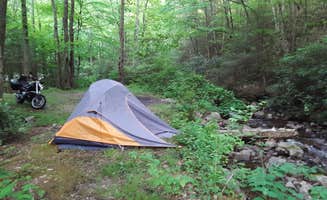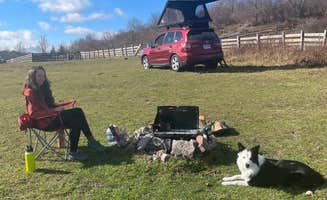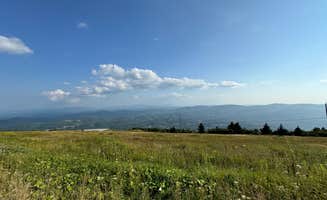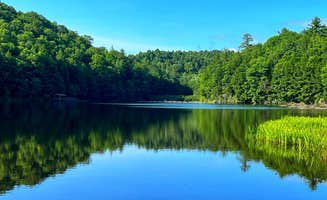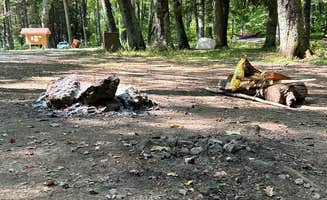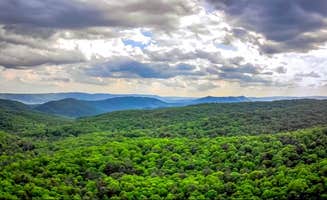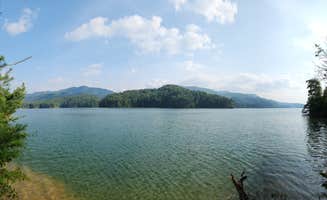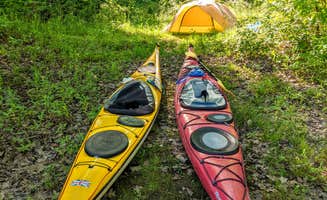Primitive camping near Sugar Grove, Virginia offers access to several established dispersed sites across multiple areas of the Jefferson and George Washington National Forests. Located in southwest Virginia along the Virginia-Tennessee-North Carolina border region, these free camping areas sit at elevations ranging from 2,000 to 5,500 feet. Winter camping requires preparation for temperatures that can drop below freezing, while summer brings moderate temperatures in the 70s-80s with cooler nights at higher elevations.
What to do
Explore mountain trails: Mount Rogers National Recreation Area provides direct access to numerous hiking paths. "Variety of types of campsites. Amazing sights and wild ponies! The AT provides some great hiking," notes Katie B., highlighting the trail diversity.
Bike the Virginia Creeper Trail: Located within a 3-mile radius of many creek-side camping sites, this popular trail offers mainly downhill riding. Alexandra T. describes the experience at Washington & Jefferson National Forest Dispersed Sites: "Loved this spot - we got lucky and parked right next to a swimming hole, had a gorgeous swim and enjoyed our time. No service, off-grid, really lovely."
Fish local waters: Multiple creeks and lakes provide fishing spots throughout the region. "Laurel bed lake at top is beautiful. Waterfalls on way up and good fishing along the way in tumbling creek," reports Betsy W. about Little Tumbling Creek.
Stargazing: Clear mountain nights offer exceptional night sky viewing in many backcountry sites. Lindsay S. describes their experience: "The night sky was one of the most memorable moments from our trip. I've never seen so many stars!"
What campers like
Creek-side camping: Many dispersed sites sit directly alongside mountain streams. Alexandra T. from Little Tumbling Creek shares: "This is a small campsite that I believe is on hunting land... Pretty large clearing to set up a tent or tents. It is very secluded from people, but no tree line or anything to camp in."
Free camping options: Most national forest dispersed sites are available without fees. "This is a wonderful spot. It has five established camp sites with fire rings and picnic tables. The bathroom is a pit style but it was still clean and didnt smell," writes Alice S. about Walnut Flats.
Wildlife sightings: The higher elevation sites provide opportunities to see wild ponies and other animals. Mateo M. from Scales Trailhead Basecamp mentions: "The salt lick for the ponies wasn't far so if you're looking for a weekend getaway with great sites, a little adventure and a whole lot of beauty this campground is for you."
Minimal light pollution: Remote sites away from towns offer darker night skies. At Whitetop, Harley G. describes: "Watching the sunset was spectacular, then being able to star gaze."
What you should know
Road conditions vary significantly: Many forest roads require high-clearance vehicles. Emerald M. from Whitetop cautions: "The road to this site is WILD, but doable! I'll leave photos of the worst spots to help you decide whether or not you should drive up to the top. We drove our 2WD Ford Maverick up the rocky road and it handled it just fine."
Weather and wind exposure: Higher elevation sites can experience harsh conditions. Whitney B. warns about Whitetop: "THE WIND IS KILLER. We ended up moving our tent to the other side of the car park at the top. There's a nice little piney forest which provided a little shelter from the wind."
Water availability: Creeks provide natural water sources, but treatment is required. One camper at Washington & Jefferson National Forest notes their "site had a good fire ring, and was on the edge of a creek that we could filter water from with ease."
Cell service limitations: Most sites have minimal to no connectivity. Knedd B. reports about Mount Rogers: "Beautiful spot right by a babbling creek that will lull you to sleep," while others note the complete absence of cell service at multiple sites.
Tips for camping with families
Consider established sites: For first-time backcountry campers with children, sites with basic amenities provide an easier transition. Dennis R. says about Walnut Flats: "5 sites, stayed in the double site. Quiet place with plenty of firewood on the ground. Occasional people driving through but a great experience!"
Road access challenges: Plan extra travel time with children when accessing remote sites. Jon M. cautions about Scales Trailhead Basecamp: "The road in is....'rocky'. High clearance 4wd needed. Not ADV friendly, unless you're very adventurous. Access by horseback would be my #1 pick."
Weather preparation: Mountain weather changes quickly, requiring extra clothing and gear. At Whitetop, one camper noted: "If there's any clouds in the sky, you're literally just in a cloud of condensation. Everything is wet. Only camp here if there's clear skies."
Safety considerations: Some areas may have challenging terrain or unexpected visitors. Glennie V. advises: "Be aware of your surroundings and always carry something on you to protect yourself!"
Tips from RVers
Site accessibility: Most dispersed sites are best suited for smaller rigs or tent camping. SomadNomad M. reports about Walnut Flats: "Nice little free campground with about 5 sites with grill fire rings level gravel drive with tent pad and lantern pole, restrooms but I didn't use them well water pump for drinking water."
Access road limitations: Many forest roads have tight turns, low clearance, or rough surfaces. Jay N. describes the route to Scales Trailhead: "Yes, the road in is rocky (& not short...probly 45 mins from the road to the campground), but anything with Subaru Outback ground clearance will be fine."
Limited hookups: Backcountry camping near Sugar Grove means true boondocking without services. Zoey T. from Hidden Valley WMA shares: "The camp area is alright - 4 ish areas to pull up to and a few tent sites... Only downside is that the road up is a pretty harsh grade for 4 miles. Our short bus Skoolie had some troubles with it."


